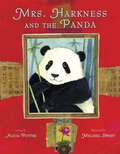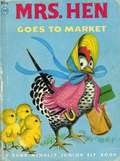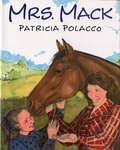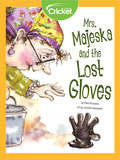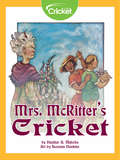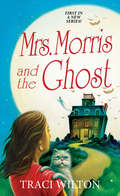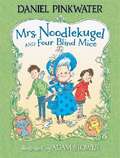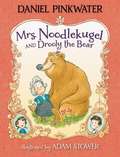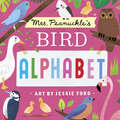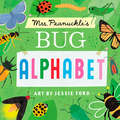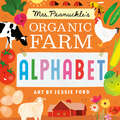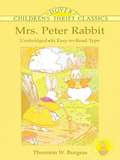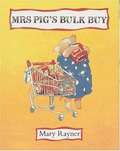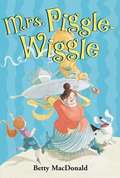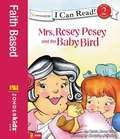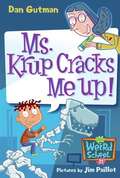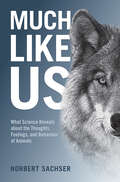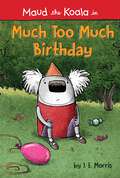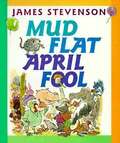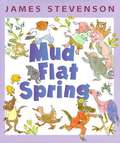- Table View
- List View
Mrs. Harkness and the Panda
by Alicia PotterIn 1934, Ruth Harkness had never seen a panda bear. Not many people in the world had.But soon the young Mrs. Harkness would inherit an expedition from her explorer husband: the hunt for a panda. She knew that bringing back a panda would be hard. Impossible, even. But she intended to try.So she went to China, where she found a guide, built traps, gathered supplies, and had explorers' clothes made—unheard of for a woman in those days. Then she set out up the Yangtze River and into the wilderness. What she discovered would awe America: an adorable baby panda she named Su Lin, which means "a little bit of something very cute."With breathtaking illustrations from Caldecott Honor artist Melissa Sweet, this little-known true story shares the tale of an adventurous woman who was bold and brave—and the unforgettable journey that helped shape American attitudes toward wildlife.
Mrs. Hen Goes to Market
by Godfrey LynnMrs. Hen is tired of her ordinary life, until something special happens on her way to the market.
Mrs. Mack
by Patricia PolaccoThe author remembers the summer when she was ten years old and staying with her father in Michigan where she took riding lessons and became best friends with a perfect horse.
Mrs. Majeska and the Lost Gloves
by Ethel PochockiWhen Mrs. Majeska finds a lost glove on her autumn walk, she feels sad—what good is one glove? When she finds its mate, she has a chance to set things right. Reuniting the pair felt like the right thing to do. When the gloves are gone the next day, she chooses to believe in a happy ending.
Mrs. McRitter's Cricket
by Heather A. MelocheMrs. McRitter finds herself unable to sleep when she discovers a chirping cricket in her house.
Mrs. Morris and the Ghost (A Salem B&B Mystery #1)
by Traci WiltonCharlene Morris knew Salem, Massachusetts had a spooky reputation. But when she decided to open her B&B there, she expected guests—not ghosts… A grieving young widow, Charlene needed a new start—so she bought a historic mansion, sight unseen, and drove from Chicago to New England to start turning it into a bed-and-breakfast. On her first night in the house, she awakens to find a handsome man with startling blue eyes in her bedroom. Terror turns to utter disbelief when he politely introduces himself as Jack Strathmore—and explains that he used to live here—when he was alive. He firmly believes that someone pushed him down the stairs three years ago, and he won’t be able to leave until someone figures out who. If Charlene wants to get her business up and running in time for the Halloween tourist rush, and get this haunting houseguest out of the way, she’ll have to investigate. Though truth be told, this ghost is starting to grow on her . . .
Mrs. Noodlekugel And Four Blind Mice (Mrs. Noodlekugel,Noodle)
by Daniel Pinkwater Adam StowerWhen Mrs. Noodlekugel’s four mice make a terrible mess with cookie crumbs at tea, she decides to take them on the bus to visit the eye doctor — and invites Nick and Maxine to come along! The mice ride on Mrs. Noodlekugel’s hat, while Mr. Fuzzface, her talking cat, has the indignity of riding in a carrier. Afterward, the hungry crew head to Dirty Sally’s Lunchroom, but the mice overdo their cheesecake and run out the door. Luckily a policeman is at the ready to help with the search — as is a rough-edged, yarn-spinning alley cat with a surprising connection to Mr. Fuzzface! It’s all a day in the life of Daniel Pinkwater’s whimsical characters, in a chapter-book series whose comical tone and cozy illustrations are sure to keep young readers coming back for more.
Mrs. Noodlekugel and Drooly the Bear
by Daniel PinkwaterWhat they don’t expect is a dripping-wet, whiskered man in the kitchen the next morning! Captain Noodlekugel has left his seafaring life to train animals for the circus, and he’s even brought with him a hefty bear named Drooly for practice. When Drooly goes missing, the siblings must try to figure out where a big clumsy bear might go.
Mrs. Peanuckle's Bird Alphabet (Mrs. Peanuckle's Alphabet #5)
by Mrs. PeanuckleFrom the albatross to the zebra finch, Mrs. Peanuckle pulls out her binoculars and introduces toddlers to 26 species of birds from all around the world. Described by a single interesting fact or defining characteristic, each bird proves to be as unique and surprising as the one before. Ever wonder why flamingoes are pink? It’s all those shrimp they eat. Are there birds that can fly backward? Yes, but hummingbirds are the only ones! With colorful, dynamic art, and attention-grabbing text, Mrs. Peanuckle’s birds fly off the page, and in some cases, into the parks and backyards of the children and adults reading this book.Mrs. Peanuckle’s Bird Alphabet is the fifth title in a series of board books celebrating the joy of nature at home and in the backyard, from fresh fruits and vegetables to birds, bugs, and trees.
Mrs. Peanuckle's Bug Alphabet (Mrs. Peanuckle's Alphabet #3)
by Mrs. PeanuckleMrs. Peanuckle’s Bug Alphabet introduces babies and toddlers to all sorts of interesting bugs. Perfect to read aloud, this creepy, crawly adventure will engage children and parents alike with its vibrant illustrations and fascinating facts about bugs. Learning the ABCs has never been so bitingly fun! Mrs. Peanuckle’s Bug Alphabet is the fourth title in a series of board books celebrating the joy of nature at home and in the backyard, from fresh fruits and vegetables to birds, flowers, and trees.
Mrs. Peanuckle's Organic Farm Alphabet (Mrs. Peanuckle's Alphabet #11)
by Mrs. PeanuckleLearn the ABC's of organic farming! Mrs. Peanuckle's alphabet books engage toddlers with interesting and informative words, graphic art, and sturdy pages.From A to Z, Mrs. Peanuckle introduces toddlers to words about organic farm life! These simple nature and farm words are sure to be a hit with curious young environmentalists, and parents and teachers who want to encourage learning about the benefits of organic farming! Collect all of Mrs. Peanuckle's Alphabet books, including Fruit, Vegetable, Bug, Flower, Bird, Tree, Hiking, Kitchen, Ocean, and Earth!
Mrs. Peter Rabbit (Dover Children's Thrift Classics)
by Thornton W. BurgessSomething is definitely wrong with Peter Rabbit . . . he has no appetite! Deciding he is terribly lonely, Peter sets off to visit some friends in the Old Pasture but instead finds himself narrowly escaping the clutches of Hooty Owl, experiencing a nasty encounter with Jed Thumper (a big gray rabbit) and eventually staring right into the soft, gentle eyes of Miss Fuzzytail. Before you know it, Peter has a new bride!Children will love sharing the adventures of Mr. and Mrs. Peter Rabbit as they start a new - and often precarious - life together in the Dear Old Briar-Patch. As they enjoy the story, youngsters absorb gentle lessons about nature, wildlife, and simple human virtues. Eight charming new illustrations, based on the originals by Harrison Cady, enhance this delightful tale, newly reprinted in large, easy-to-read type.
Mrs. Pig Gets Cross and Other Stories
by Mary RaynerSeven stories about a pig family with nine mischevious children.
Mrs. Pig's Bulk Buy
by Mary RaynerFrom the book: Once when the ten piglets were very small, their mother, Mrs. Pig, had a problem. Her piglets were all fond of ketchup, too fond. They ate it on everything. No matter how hard Mrs. Pig tried to cook things they would like, they never tasted it; everything was covered with ketchup -- even dessert -- before they ate it. Not until one day at the supermarket, when there was a big sale on ketchup, did Mrs. Pig think of a way to solve her problem. She bought six enormous jars. And brought them home. Though there may be no fierce wolf after the piglets this time, their situation is almost as grave, and the final results are just as funny and even more lasting than the ones in Mr. and Mrs. Pig's Evening Out and Garth Pig and the Ice Cream Lady. Other books about the Pig family are available from Bookshare.
Mrs. Piggle-Wiggle
by Betty MacdonaldMrs. Piggle-Wiggle lives in an upside-down house and smells like cookies. She was even married to a pirate once! She has treatments for all difficult children.
Mrs. Rosey Posey and the Baby Bird (I Can Read! #Level 2)
by Robin Jones GunnMrs. Rosey Posey is an eccentric grandmotherly character created by bestselling author Robin Jones Gunn. Mrs. Rosey Posey tells stories to the neighborhood children and teaches them how God loves and cares for them. A lesson in God's care for us. Rachel finds a baby bird that has fallen from its nest. "No one else saw it," she tells Mrs. Rosey Posey. But MRS. Rosey Posey knows that someone else did see it.
Mrs. Wigglesworth's Secret
by Robyn SupranerA little girl who wants to be a detective finds an interesting case right next door. in this easy to read mystery for second and third graders Audrey is spying on her neighbor, Mrs. Wigglesworth who sparkles with diamonds and can't get enough TV sets. She watches more than ten TV shows at the same time. Audrey sneaks into her neighbor's house and truck to find out. She watches the chubby lady in the pink dress through her spy glass and follows her around. Mrs. Wigglesworth's secret will be a big surprise! Many pictures are described.
Ms. Krup Cracks Me Up! (My Weird School #21)
by Dan Gutman Jim PaillotA.J. thinks that nothing can possibly be as boring as a sleepover in the natural history museum. But anything can happen when Ms. Krup is in charge. The tour guide says that dinosaur skeletons come to life in the middle of the night. Is she right?
Much Like Us: What Science Reveals about the Thoughts, Feelings, and Behaviour of Animals
by Norbert SachserWhat really differentiates us from our relatives in the animal world? And what can they teach us about ourselves? Taking these questions as his starting point, Norbert Sachser presents fascinating insights into the inner lives of animals, revealing what we now know about their thoughts, feelings and behaviour. By turns surprising, humourous and thought-provoking, Much Like Us invites us on a journey around the animal kingdom, explaining along the way how dogs demonstrate empathy, why chimpanzees wage war and how crows and ravens craft tools to catch food. Sachser brings the science to life with examples and anecdotes drawn from his own research, illuminating the vast strides in understanding that have been made over the last 30 years. He ultimately invites us to challenge our own preconceptions – the closer we look, the more we see the humanity in our fellow creatures.
Much Too Much Birthday (Maud the Koala)
by J. E. MorrisMaud the koala can't wait for her birthday party--until everything starts to feel way too overwhelming.Maud is having a birthday party in her backyard, and she's invited her friends--all fifty-six of them--to celebrate with her. She's not worried, though. After all, you can never have too much birthday! But when the guests arrive and the party gets packed, she isn't so sure. What will happen if Maud can't bear her own birthday?J. E. Morris's charming illustrations and comic-like panels make this a unique format with a narrative style perfect for storytime.
Mud Builders
by Meish GoldishMeet four master animal mud builders and discover how they work with mud.
Mud Flat April Fool
by James StevensonSomething peculiar is going on in the village of Mud Flat today. Mr. Duffy has disappeared in a puff of green smoke, and Brian woke up with his head on backward. Doris is greeted by a singing tree, and poor Lila sniffs a rose that promptly squirts in her eye. What is this strange brand of spring fever? James Stevenson provides the happy answer in another hilarious visit with the lovable residents of Mud Flat.
Mud Flat Spring
by James StevensonWelcome back to Mud Flat, James Stevenson's strangely familiar, always surprising, often curious town where all the lovable citizens have something to say. <P>This time the topic of most conversations is spring, and everyone is talking -- dancing -- or both. This fifth book in the "Mud Flat" series features nine easy-to-read, buoyant chapters and Stevenson's signature full-color illustrations on every page.
